CoastalCruiser
New Member
Maybe 1/4" cable clamps (essentially tiny u-bolts) to hold the bmx rim onto the spokes?
Maybe 1/4" cable clamps (essentially tiny u-bolts) to hold the bmx rim onto the spokes?
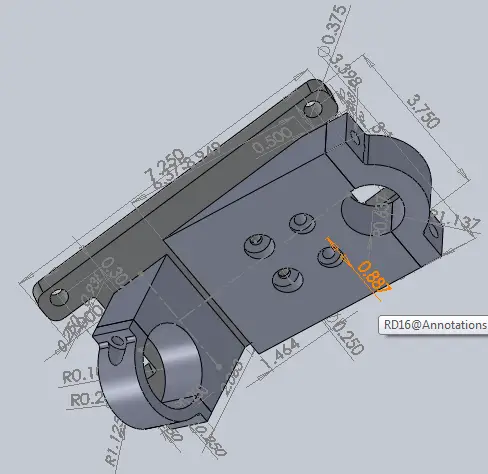
Took apart the lawn mower transmission tonight. It's a whole mess of weird pulleys, rusted bolts, and sticky bearings. I don't think I can use much of anything from it, since the shaft has a hexagonal cross section and the pulleys seem to be taper-fit. I'm not exactly sure about that, since most of the bolts are frozen and I can't get the two main pulleys off the shaft. I'll probably use a go-kart jack shaft and some pillow block bearings after all. At least I have a couple idler pulleys and a carburetor for free!
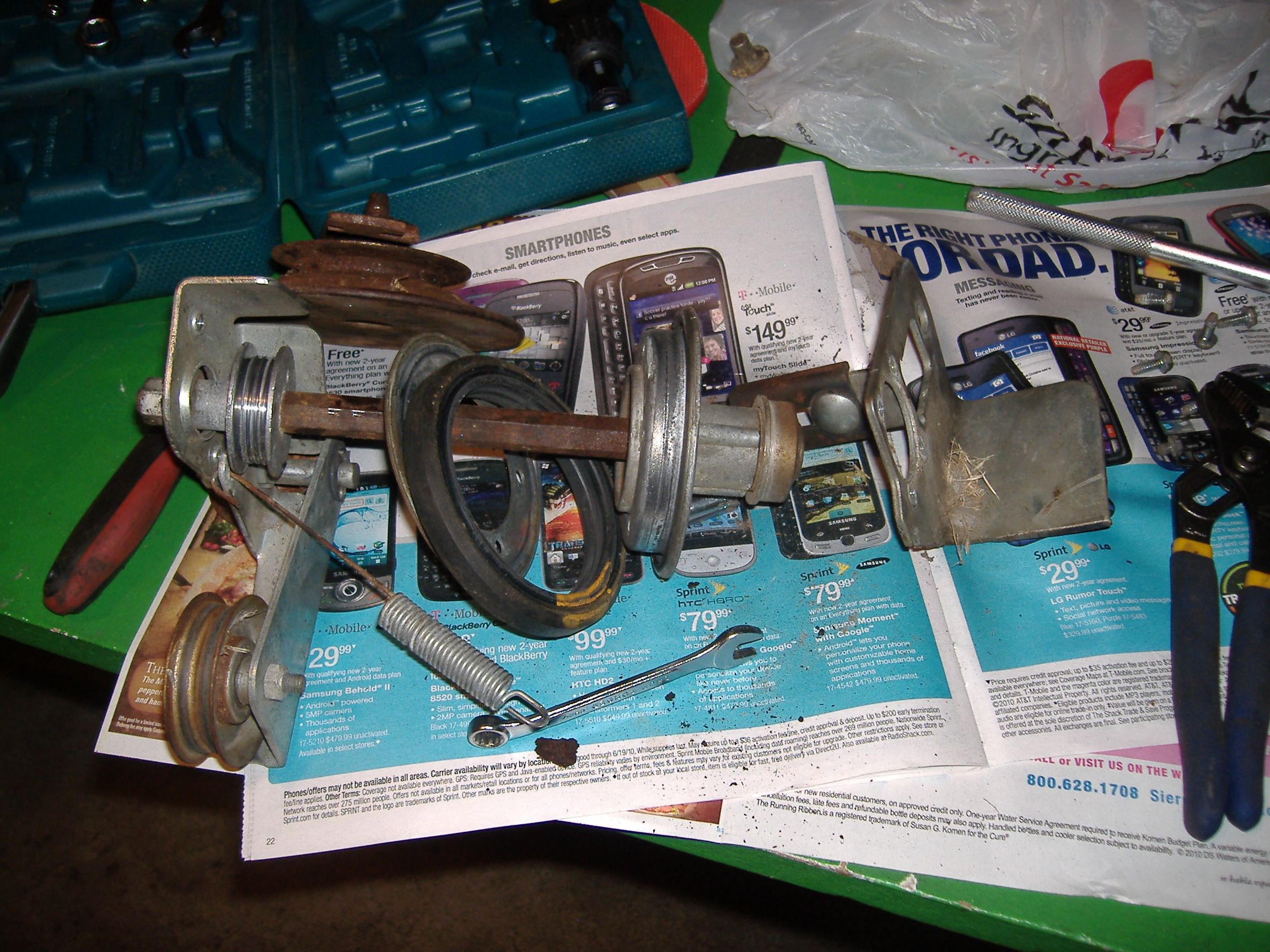
Speaking of finding things on the road, look what my roommate found walking around! We gave him a bowl of milk and a couch to sleep on, but he'll probably be going to the pound tomorrow since I'm allergic.
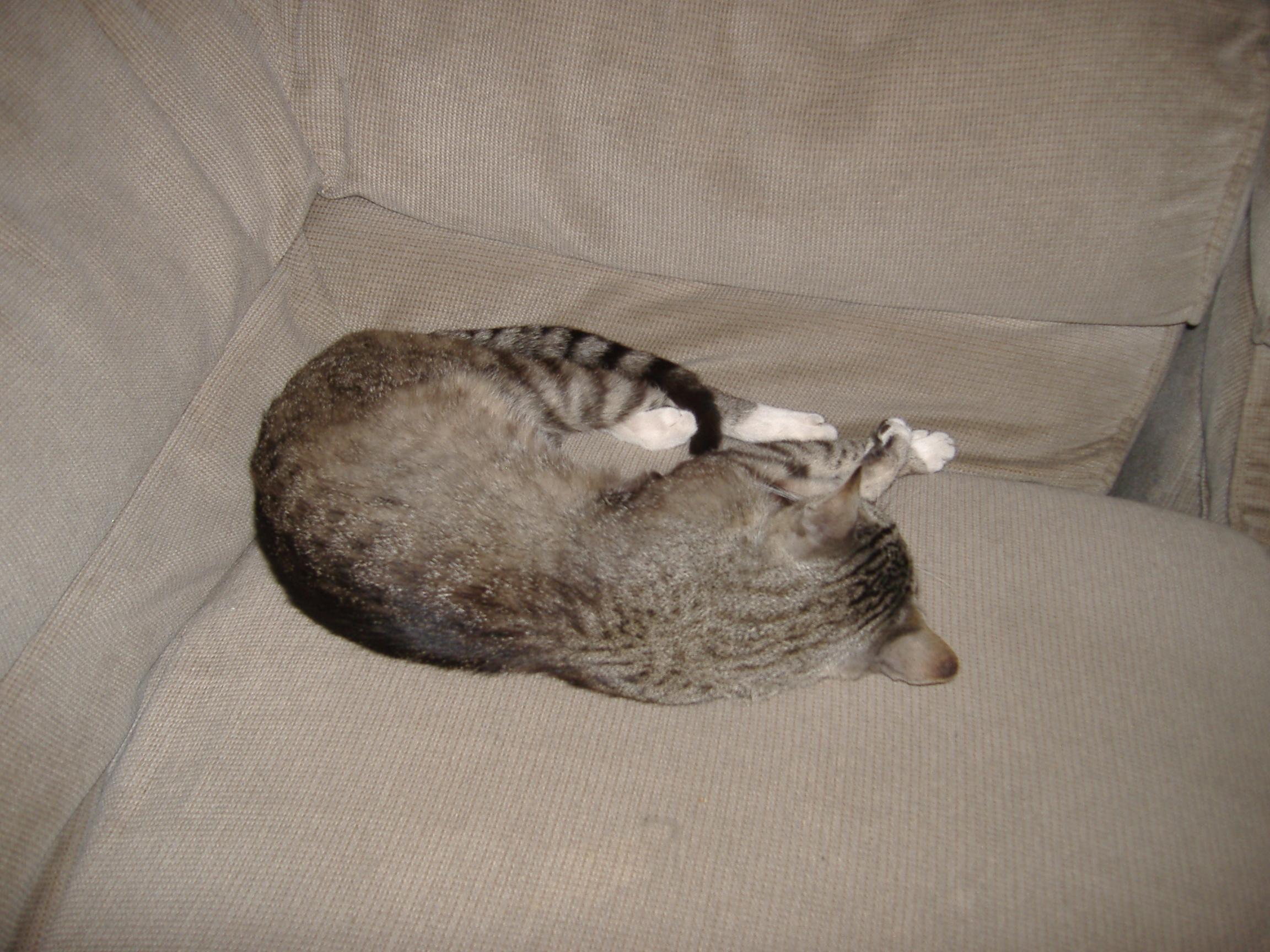

Got some photos of the engine sitting on the frame, without motor mounts. I'm thinking about mounting it tilted forward a bit, but I'm not sure if that would screw up the oiling system. Maybe I can modify the oil slinger to make it work? Or I could tilt it the other way, so that the cam and oil slinger are under the oil level.
Tilting it would give me better clearance for the spark plug and the carburetor, but I would have to get a special intake pipe either way.
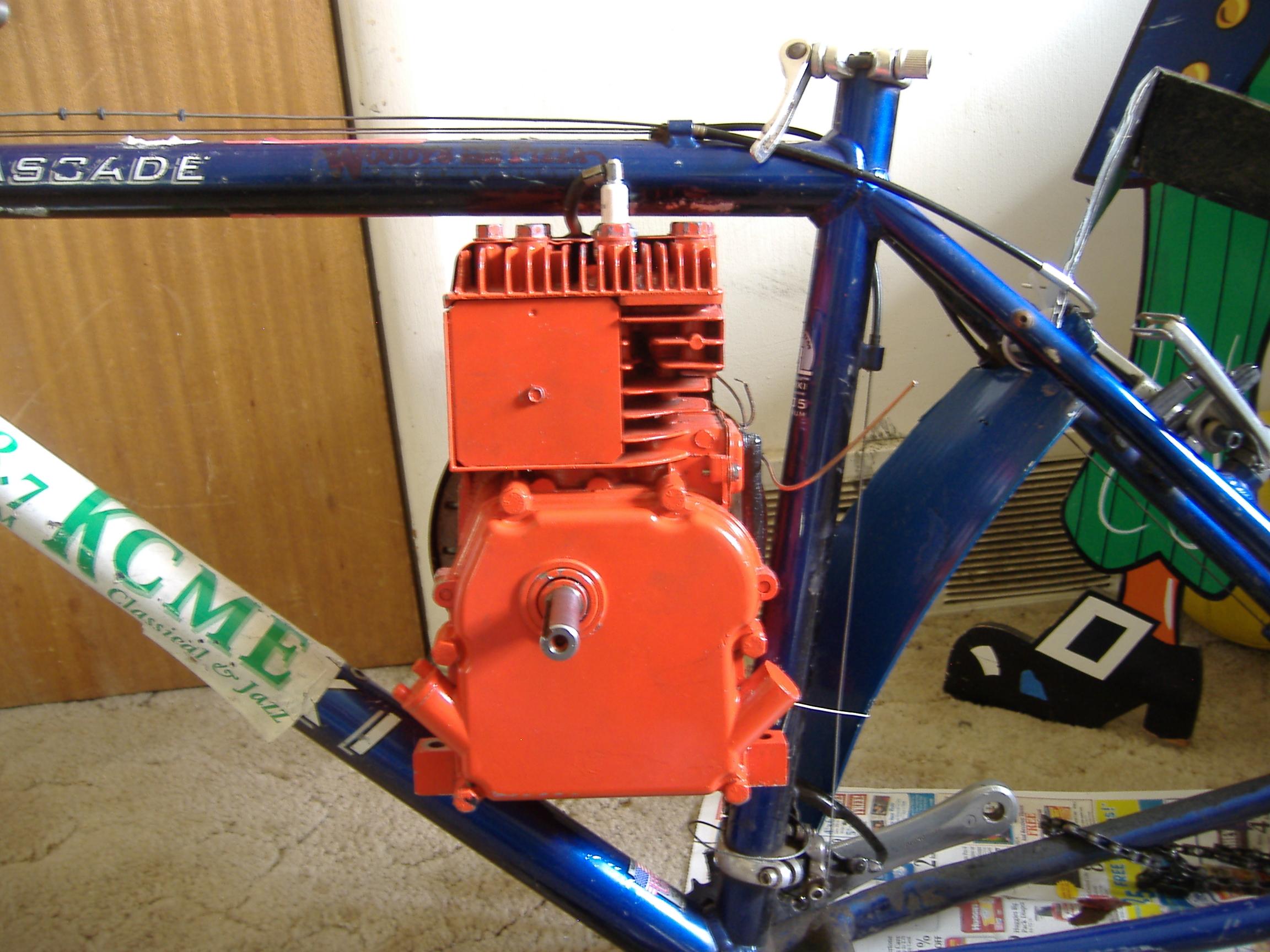
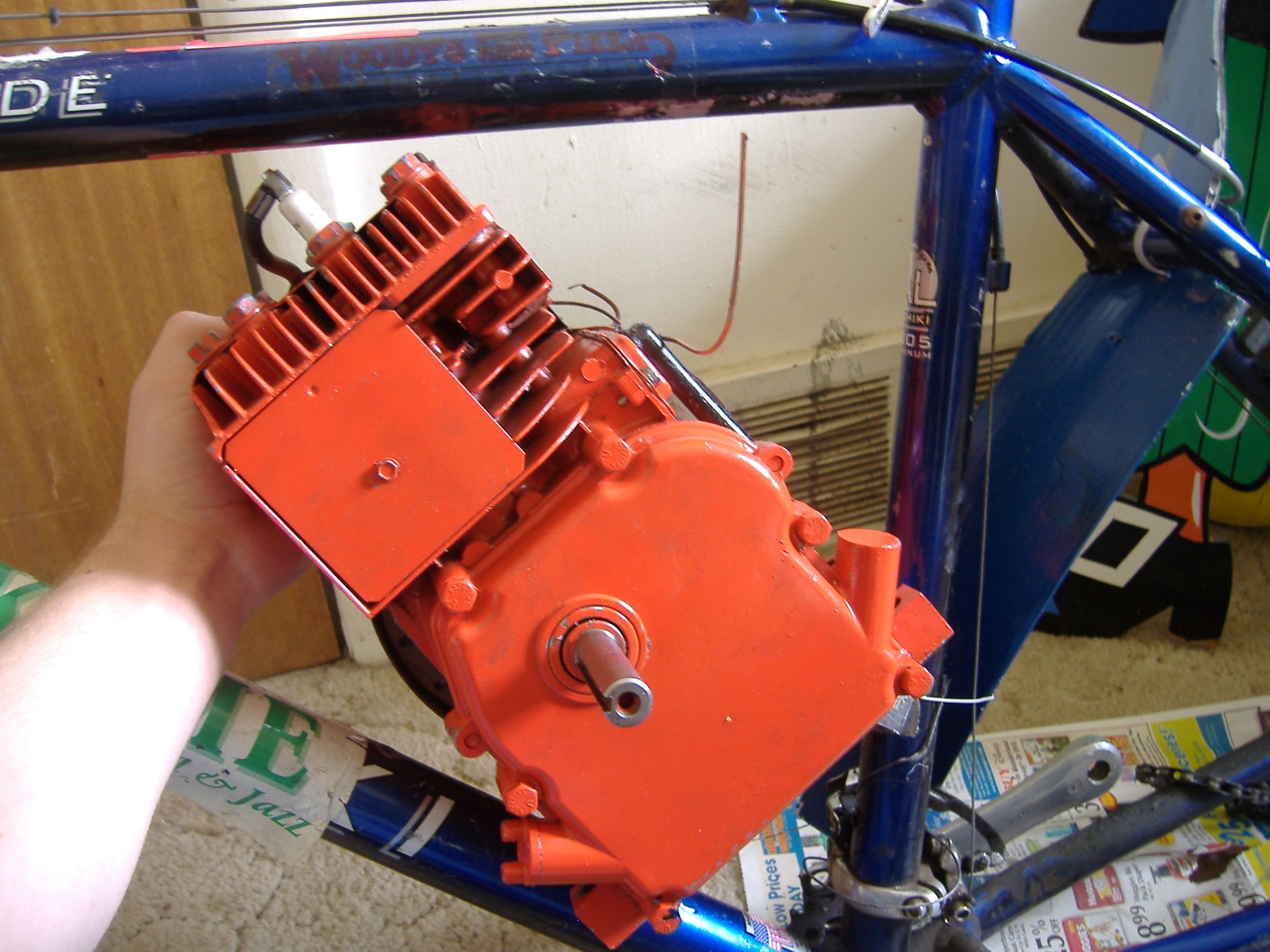

I'D BE REPLING TO THE LAST IN THE THREAD, BUT THE PICS, 1ST OF TWO ARE ALREADY HERE.
The first of two pics of your bike frame with engine not tilted, see:
FLYWHEEL AN COVER EDGE FORWARD CURVED SHAPE INLINE WITH CRANK SHAFT UP AND TO THE LEFT
This is what I am talking about. You can see the edge of the recoil pull start/flywheel cover edge only.
Yes edge only, there is no cover in the roughly half moon shaped area, it exposes as you can see the magnet or opposing weight on the flywheel.
I can contact Briggs directly or email and check on this, I guess I sometimes get lazy and well I already made a cover, hope no adverse effect. Only since the governor linkage cannot go around a bend with the elbow of the Techumseh adaption to make engine intake fit frame, I am not concerned about air vane being adversely affected. I remove the air vane anyway. The air flow cooling is what I am concerned about. I think the fins on the flywheel pull the air through the perforated finger guard by the recoil pull start of the flywheel cover, so I feel that no problem there, but will see what they say.
Another web site to check Hit N Miss Enterprises Antique Gas Engines and Parts Hit & Miss Enterprises they have sales but also free info and list serv too. Lots of pics old antique engines.
As for two magnets, no just a fake counter weight.
Rivets of some type, two of them you can also see. This probably means that this is the magnet portion showing. You can put a piece of iron near it to tell, but I would think the non magnet counter weight is just machined along with the rest of the part in mfg. The magnet added later needed to be riveted on.
Handy to know also, put the non magnet counter weight rotated to opposite the magneto lapped metal induction area with an ordinary piece of printer paper. I use it one or two thicknesses. Then I only loosen the two screws holding the magneto in place just enough so you can push the magneto close to the flywheel counter weight.
Then while holding it there tighten up the two screws. Turn the flywheel and the paper comes out stiffly and hopefully the magnet and the counter weight of the flywheel both are very close to the magneto when the flywheel rotates. Too far away and you don't get a very good spark. Try to do this adjustment without this method and especially with the magnet adjacent to the magneto and it just get pulled in and stuck to the magneto.
I use fine emery cloth to sand off both the magneto lapping two curved areas, but only lightly and also the magnet to help with better spark. A point file between the point, or very thin and fine emery cloth folded with abrasive area out on both side between point with closed position do this. Sand slightly and re-gap to help remove point pits, burns, uneven surfaces to get hotter spark.
To reply to the mentioning of points, they are under the cover of the flywheel with a thin metal cover where the low tension lead comes out (goes to kill switch to ground). There is no coil, just the magneto. No rotor as in a multi cylinder engine, just a little shaved spot on the crank shaft by the points.
A little rod goes into the recess and allows the points to come apart. At compression stroke about 8 degrees before top dead center (point gap the .020 inch determines) the shaved spot allows a spring tensioned one side of the points to move outward and break contact with the opposite side of the contact points.
At the time the points open the grounded movable side of the points through a copper or tinned braided wire going to a screw with external tooth start lock washer to ground opens the short to the magneto's primary coil. To clarify, the opening of this short to ground actually stops the charging circuit to the primary. This then causes the field collapse and a flyback effect transfers a large voltage on the magneto's secondary (high tension to spark plug). The flyback effect is same as a battery powered coil, point open and 12 volts no longer on the primary, secondary high tension sparks.
A machine shop is definitely handy and I just can't afford to be going there with fees on going. The welding is just something not sufficient to do at home. I could make jewelry with the small oxy mapp gas stuff, but not much else.
Thinking the post somewhere else on the site about gas tank from two small empty propane tanks and the problem with weld/braze ect and leak problem. I thought of removing an old small pony scuba aluminum 13 cubic foot tank I have from service (note 13 CF at 3000 PSI). I would adapt it to hold gasoline for a motor bike gravity feed to carb bowl system. Size volume is about 1 liter I think. You would not have to be concerned much about strength as it is heavy weight aluminum.
Ah, last to mention I have to see about screens I got at HW store for vents and to adapt to guard muffler and pipe. I pick from trash an old stainless steel BBQ and to use the metal already formed nicely to cover moving parts (chain guard, belt, jack shaft ect).
Measure Twice

I'D BE REPLING TO THE LAST IN THE THREAD, BUT THE PICS, 1ST OF TWO ARE ALREADY HERE.
The first of two pics of your bike frame with engine not tilted, see:
FLYWHEEL AN COVER EDGE FORWARD CURVED SHAPE INLINE WITH CRANK SHAFT UP AND TO THE LEFT
This is what I am talking about. You can see the edge of the recoil pull start/flywheel cover edge only.
Yes edge only, there is no cover in the roughly half moon shaped area, it exposes as you can see the magnet or opposing weight on the flywheel.
I can contact Briggs directly or email and check on this, I guess I sometimes get lazy and well I already made a cover, hope no adverse effect. Only since the governor linkage cannot go around a bend with the elbow of the Techumseh adaption to make engine intake fit frame, I am not concerned about air vane being adversely affected. I remove the air vane anyway. The air flow cooling is what I am concerned about. I think the fins on the flywheel pull the air through the perforated finger guard by the recoil pull start of the flywheel cover, so I feel that no problem there, but will see what they say.
Another web site to check Hit N Miss Enterprises Antique Gas Engines and Parts Hit & Miss Enterprises they have sales but also free info and list serv too. Lots of pics old antique engines.
As for two magnets, no just a fake counter weight.
Rivets of some type, two of them you can also see. This probably means that this is the magnet portion showing. You can put a piece of iron near it to tell, but I would think the non magnet counter weight is just machined along with the rest of the part in mfg. The magnet added later needed to be riveted on.
Handy to know also, put the non magnet counter weight rotated to opposite the magneto lapped metal induction area with an ordinary piece of printer paper. I use it one or two thicknesses. Then I only loosen the two screws holding the magneto in place just enough so you can push the magneto close to the flywheel counter weight.
Then while holding it there tighten up the two screws. Turn the flywheel and the paper comes out stiffly and hopefully the magnet and the counter weight of the flywheel both are very close to the magneto when the flywheel rotates. Too far away and you don't get a very good spark. Try to do this adjustment without this method and especially with the magnet adjacent to the magneto and it just get pulled in and stuck to the magneto.
I use fine emery cloth to sand off both the magneto lapping two curved areas, but only lightly and also the magnet to help with better spark. A point file between the point, or very thin and fine emery cloth folded with abrasive area out on both side between point with closed position do this. Sand slightly and re-gap to help remove point pits, burns, uneven surfaces to get hotter spark.
To reply to the mentioning of points, they are under the cover of the flywheel with a thin metal cover where the low tension lead comes out (goes to kill switch to ground). There is no coil, just the magneto. No rotor as in a multi cylinder engine, just a little shaved spot on the crank shaft by the points.
A little rod goes into the recess and allows the points to come apart. At compression stroke about 8 degrees before top dead center (point gap the .020 inch determines) the shaved spot allows a spring tensioned one side of the points to move outward and break contact with the opposite side of the contact points.
At the time the points open the grounded movable side of the points through a copper or tinned braided wire going to a screw with external tooth start lock washer to ground opens the short to the magneto's primary coil. To clarify, the opening of this short to ground actually stops the charging circuit to the primary. This then causes the field collapse and a flyback effect transfers a large voltage on the magneto's secondary (high tension to spark plug). The flyback effect is same as a battery powered coil, point open and 12 volts no longer on the primary, secondary high tension sparks.
A machine shop is definitely handy and I just can't afford to be going there with fees on going. The welding is just something not sufficient to do at home. I could make jewelry with the small oxy mapp gas stuff, but not much else.
Thinking the post somewhere else on the site about gas tank from two small empty propane tanks and the problem with weld/braze ect and leak problem. I thought of removing an old small pony scuba aluminum 13 cubic foot tank I have from service (note 13 CF at 3000 PSI). I would adapt it to hold gasoline for a motor bike gravity feed to carb bowl system. Size volume is about 1 liter I think. You would not have to be concerned much about strength as it is heavy weight aluminum.
Ah, last to mention I have to see about screens I got at HW store for vents and to adapt to guard muffler and pipe. I pick from trash an old stainless steel BBQ and to use the metal already formed nicely to cover moving parts (chain guard, belt, jack shaft ect).
Measure Twice

I'D BE REPLING TO THE LAST IN THE THREAD, BUT THE PICS, 1ST OF TWO ARE ALREADY HERE.
The first of two pics of your bike frame with engine not tilted, see:
FLYWHEEL AN COVER EDGE FORWARD CURVED SHAPE INLINE WITH CRANK SHAFT UP AND TO THE LEFT
This is what I am talking about. You can see the edge of the recoil pull start/flywheel cover edge only.
Yes edge only, there is no cover in the roughly half moon shaped area, it exposes as you can see the magnet or opposing weight on the flywheel.
I can contact Briggs directly or email and check on this, I guess I sometimes get lazy and well I already made a cover, hope no adverse effect. Only since the governor linkage cannot go around a bend with the elbow of the Techumseh adaption to make engine intake fit frame, I am not concerned about air vane being adversely affected. I remove the air vane anyway. The air flow cooling is what I am concerned about. I think the fins on the flywheel pull the air through the perforated finger guard by the recoil pull start of the flywheel cover, so I feel that no problem there, but will see what they say.
Another web site to check Hit N Miss Enterprises Antique Gas Engines and Parts Hit & Miss Enterprises they have sales but also free info and list serv too. Lots of pics old antique engines.
As for two magnets, no just a fake counter weight.
Rivets of some type, two of them you can also see. This probably means that this is the magnet portion showing. You can put a piece of iron near it to tell, but I would think the non magnet counter weight is just machined along with the rest of the part in mfg. The magnet added later needed to be riveted on.
Handy to know also, put the non magnet counter weight rotated to opposite the magneto lapped metal induction area with an ordinary piece of printer paper. I use it one or two thicknesses. Then I only loosen the two screws holding the magneto in place just enough so you can push the magneto close to the flywheel counter weight.
Then while holding it there tighten up the two screws. Turn the flywheel and the paper comes out stiffly and hopefully the magnet and the counter weight of the flywheel both are very close to the magneto when the flywheel rotates. Too far away and you don't get a very good spark. Try to do this adjustment without this method and especially with the magnet adjacent to the magneto and it just get pulled in and stuck to the magneto.
I use fine emery cloth to sand off both the magneto lapping two curved areas, but only lightly and also the magnet to help with better spark. A point file between the point, or very thin and fine emery cloth folded with abrasive area out on both side between point with closed position do this. Sand slightly and re-gap to help remove point pits, burns, uneven surfaces to get hotter spark.
To reply to the mentioning of points, they are under the cover of the flywheel with a thin metal cover where the low tension lead comes out (goes to kill switch to ground). There is no coil, just the magneto. No rotor as in a multi cylinder engine, just a little shaved spot on the crank shaft by the points.
A little rod goes into the recess and allows the points to come apart. At compression stroke about 8 degrees before top dead center (point gap the .020 inch determines) the shaved spot allows a spring tensioned one side of the points to move outward and break contact with the opposite side of the contact points.
At the time the points open the grounded movable side of the points through a copper or tinned braided wire going to a screw with external tooth start lock washer to ground opens the short to the magneto's primary coil. To clarify, the opening of this short to ground actually stops the charging circuit to the primary. This then causes the field collapse and a flyback effect transfers a large voltage on the magneto's secondary (high tension to spark plug). The flyback effect is same as a battery powered coil, point open and 12 volts no longer on the primary, secondary high tension sparks.
A machine shop is definitely handy and I just can't afford to be going there with fees on going. The welding is just something not sufficient to do at home. I could make jewelry with the small oxy mapp gas stuff, but not much else.
Thinking the post somewhere else on the site about gas tank from two small empty propane tanks and the problem with weld/braze ect and leak problem. I thought of removing an old small pony scuba aluminum 13 cubic foot tank I have from service (note 13 CF at 3000 PSI). I would adapt it to hold gasoline for a motor bike gravity feed to carb bowl system. Size volume is about 1 liter I think. You would not have to be concerned much about strength as it is heavy weight aluminum.
Ah, last to mention I have to see about screens I got at HW store for vents and to adapt to guard muffler and pipe. I pick from trash an old stainless steel BBQ and to use the metal already formed nicely to cover moving parts (chain guard, belt, jack shaft ect).
Measure Twice

I contacted Briggs and Stratton and checked with a few shops too on the missing part of the flywheel cover on this pictured and my engine also. My engine 80202-0430-01.
Correction there is no part you can buy and there never was, except to buy a whole new flywheel cover, which they don't make anymore. The guy at the shop said that what I had done to fix it makes sense. When I looked at the corresponding area with the half moon shape on the flywheel cover near the intake an exhaust ports, I can see where it is a piece of sheet metal tack welded on. Most of the old covers must lose the forward one more easily as much as I can tell from rusting. It is imperative to cover this area for safety of user and the engine itself. The airflow does require it to be there for the design in the cooling as well. The air goes through the suction of the fins on the flywheel and across the fins on the cylinder and the turns right angle back when hitting the square plate that screws on with one screw to cover the cylinder fins. It is removable to allow access to clean grass clipping and debris out of the fins on the cylinder during maintenance.
If you make the repair as close to original to the vacant sheet metal part of the flywheel cover that leaves this dangerous gap, it would be by welding sheet metal back where it is suppose to be.
My time was up for membership where I was doing TIG welding, so I opted to fabricate a part that fits on by using existing threads in the engine and mounts. I have the pictures see attached.
Measure Twice
======================================================
FEW MORE PICS OF FIX
Another view of flywheel cover gap with text inserted
Measure Twice
PS other:
I found and ordered my muffler from a shop for a Briggs & Stratton part that has spark arrestor built into the muffler, hope that satisfies the state DMV for off roading
Hi folks,
I've been lurking here a bit, gathering info on what kind of engine I could put on my old mountain bike. I can't afford one of the Huasheng/Honda 4-stroke kits right now, and I've heard all kinds of things about the Chinese 2-strokes exploding after a few miles. So when I saw a 3 hp Briggs & Stratton motor on craigslist for $30, I decided to build my own. My goal for this project is to keep the budget under $100.
My plan right now is to get the motor mounted in the frame, and figure other stuff out later. The engine doesn't quite fit, so I'm going to cut some notches in the bottom of the engine for clearance, near the bolt holes for mounting the engine. Then I'll make some motor mounts, either by sand-casting them out of aluminum or by borrowing a welder and fabbing them from steel. I'll probably have to re-route the intake and exhaust too, maybe going to a float-type carburetor.
For the transmission, I'm going with a belt drive like a Whizzer, with a smaller wheel rim as the rear pulley. I can either use a centrifugal clutch with a pulley or use an adjustable tensioner to engage or disengage the belt. With a 3.2" engine pulley this will give me a speed of 35 mph at 3,000 rpm. Not the best gear ratio, but maybe I'll add a jackshaft or a gear reduction later.
So, what do you think? Should I go with a centrifugal go-kart clutch or make my own manual friction clutch?






